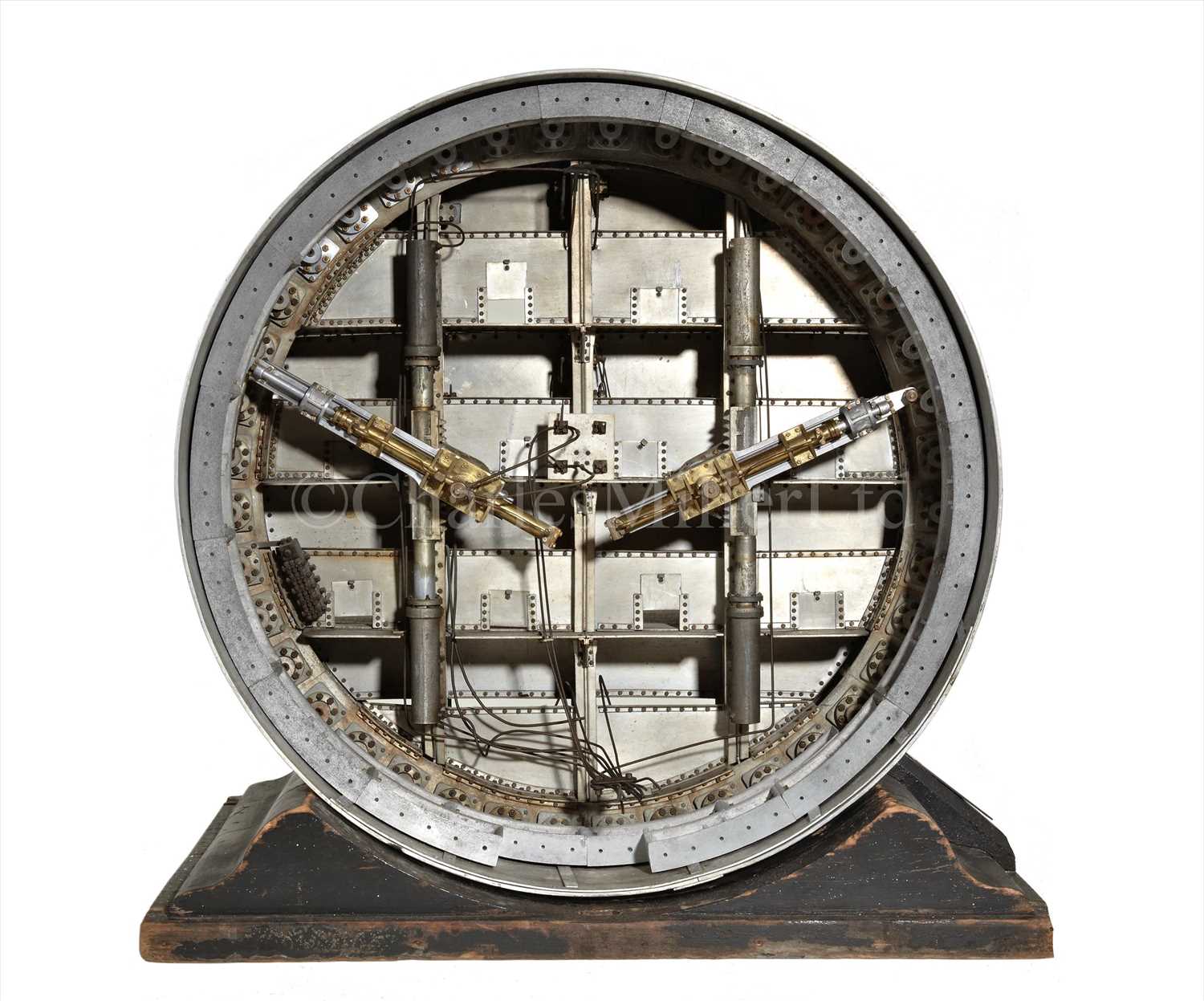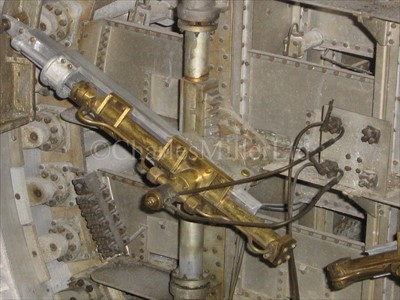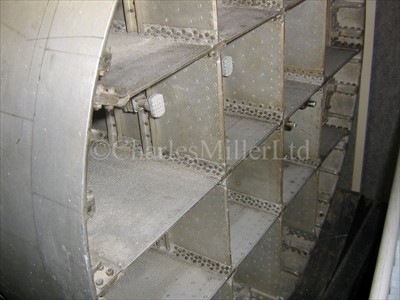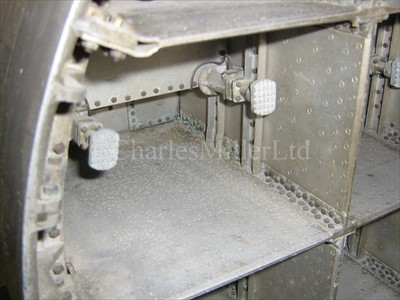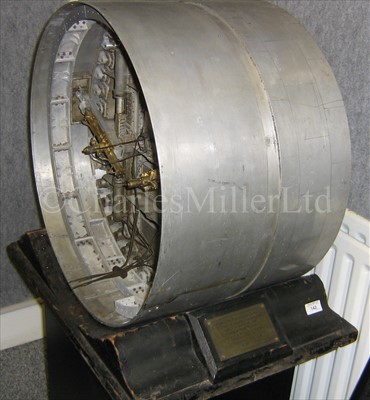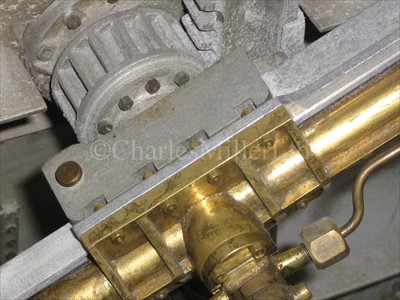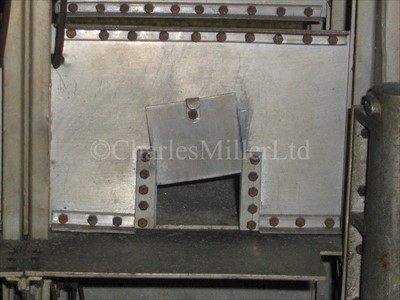20th Apr, 2011 12:00
Maritime and Scientific Models, Instruments & Art (Princess)
142
[M] AN HISTORICALLY INTERESTING 1:16 SCALE...
AN HISTORICALLY INTERESTING 1:16 SCALE WORKING DEMONSTRATION MODEL OF THE TUNNELLING SHIELD USED TO EXCAVATE THE ROTHERHITHE TUNNEL AND INSPECTED BY THE PRINCE AND PRINCESS OF WALES AT THE OPENING ON 12 JUNE, 1908
constructed in aluminium and brass with hydraulic plate-delivery piston arms supported in front of excavation platforms with removable guards, loosely supported on an ebonised wooden base with plate inscribed MODEL OF THE TUNNELLING SHIELD / 30 FEET 8 INCHES IN DIAMETER / USED IN DRIVING THE / ROTHERHITHE TUNNEL / UNDER THE RIVER THAMES. / PRESENTED BY / J. HENRY PRICE / ASSOC. M. INST. C.E. -- 24½ x 23in. (62.3 x 58.8cm.)
Designed by Maurice Fitzmaurice (Engineer to the London County Council and built by contractors Price & Reeves between 1904 and 1908 at a cost of about £1 million (and eighteen months ahead of schedule), the tunnel was built to alleviate congestion which had not been dealt with by the opening of the tunnel at Dartford. Excavated partly using a tunnelling shield and partly through cut-and-cover methods, it was the largest of its kind then built and the first to require a shield to turn a corner -- the entrance arches of the tunnel are in fact the cutting edges of the original tunnelling shield, forming in effect a loading gauge. Consisting of a single bore 4,860 feet 48 feet below the high-water level of the Thames, with a maximum depth of 75 feet below the surface, the Rotherhithe Tunnel was designed towards the end of the horse-drawn era and so has characteristics the modern motorist finds perplexing, if not dangerous: It has a shallow gradient to cater for non-mechanised traffic which, prior to the London Barrier, was prone to flooding; the route includes nearly right-angled bends at the points where the tunnel goes under the river bed preventing horses from seeing daylight at the end of the tunnel too early which might make them bolt for the exit; and it now caters for 34,000 vehicles a day, vastly exceeding the designed quota of 2,600, creating one of London's worst bottlenecks. However, notwithstanding these modern gripes, the opening in 1908 was, according to The Times, a rather glittering affair: The Prince and Princess left Marlborough House at a quarter to 3 in an open landau, which was drawn by four horses, with postilions and outriders. Their Royal Highnesses were accompanied by an escort of Household Cavalry... [they] proceeded.. by way of the Mall, Westminster-bridge, St. George's-road, New Kent-road, Tower-bridge-road, Spa-road, Jamaica-road, and Union-road. Large crowds assembled in the streets, which were gay with bunting and mottoes of welcome; and their Royal Highnesses given a most enthusiastic reception. After the formalities had been observed, they proceeded through the tunnel and a reception in a special pavilion: Inside the room was a model of the shield used in the construction of the tunnel, the working of which the chief engineer explained to the Prince and Princess... Returning via Stepney, the Royal procession enjoyed a similar turnout to that seen on arrival.
constructed in aluminium and brass with hydraulic plate-delivery piston arms supported in front of excavation platforms with removable guards, loosely supported on an ebonised wooden base with plate inscribed MODEL OF THE TUNNELLING SHIELD / 30 FEET 8 INCHES IN DIAMETER / USED IN DRIVING THE / ROTHERHITHE TUNNEL / UNDER THE RIVER THAMES. / PRESENTED BY / J. HENRY PRICE / ASSOC. M. INST. C.E. -- 24½ x 23in. (62.3 x 58.8cm.)
Designed by Maurice Fitzmaurice (Engineer to the London County Council and built by contractors Price & Reeves between 1904 and 1908 at a cost of about £1 million (and eighteen months ahead of schedule), the tunnel was built to alleviate congestion which had not been dealt with by the opening of the tunnel at Dartford. Excavated partly using a tunnelling shield and partly through cut-and-cover methods, it was the largest of its kind then built and the first to require a shield to turn a corner -- the entrance arches of the tunnel are in fact the cutting edges of the original tunnelling shield, forming in effect a loading gauge. Consisting of a single bore 4,860 feet 48 feet below the high-water level of the Thames, with a maximum depth of 75 feet below the surface, the Rotherhithe Tunnel was designed towards the end of the horse-drawn era and so has characteristics the modern motorist finds perplexing, if not dangerous: It has a shallow gradient to cater for non-mechanised traffic which, prior to the London Barrier, was prone to flooding; the route includes nearly right-angled bends at the points where the tunnel goes under the river bed preventing horses from seeing daylight at the end of the tunnel too early which might make them bolt for the exit; and it now caters for 34,000 vehicles a day, vastly exceeding the designed quota of 2,600, creating one of London's worst bottlenecks. However, notwithstanding these modern gripes, the opening in 1908 was, according to The Times, a rather glittering affair: The Prince and Princess left Marlborough House at a quarter to 3 in an open landau, which was drawn by four horses, with postilions and outriders. Their Royal Highnesses were accompanied by an escort of Household Cavalry... [they] proceeded.. by way of the Mall, Westminster-bridge, St. George's-road, New Kent-road, Tower-bridge-road, Spa-road, Jamaica-road, and Union-road. Large crowds assembled in the streets, which were gay with bunting and mottoes of welcome; and their Royal Highnesses given a most enthusiastic reception. After the formalities had been observed, they proceeded through the tunnel and a reception in a special pavilion: Inside the room was a model of the shield used in the construction of the tunnel, the working of which the chief engineer explained to the Prince and Princess... Returning via Stepney, the Royal procession enjoyed a similar turnout to that seen on arrival.
Sold for £3,472
Estimated at £1,000 - £1,500
(inc. buyer's premium of 24%)
AN HISTORICALLY INTERESTING 1:16 SCALE WORKING DEMONSTRATION MODEL OF THE TUNNELLING SHIELD USED TO EXCAVATE THE ROTHERHITHE TUNNEL AND INSPECTED BY THE PRINCE AND PRINCESS OF WALES AT THE OPENING ON 12 JUNE, 1908
constructed in aluminium and brass with hydraulic plate-delivery piston arms supported in front of excavation platforms with removable guards, loosely supported on an ebonised wooden base with plate inscribed MODEL OF THE TUNNELLING SHIELD / 30 FEET 8 INCHES IN DIAMETER / USED IN DRIVING THE / ROTHERHITHE TUNNEL / UNDER THE RIVER THAMES. / PRESENTED BY / J. HENRY PRICE / ASSOC. M. INST. C.E. -- 24½ x 23in. (62.3 x 58.8cm.)
Designed by Maurice Fitzmaurice (Engineer to the London County Council and built by contractors Price & Reeves between 1904 and 1908 at a cost of about £1 million (and eighteen months ahead of schedule), the tunnel was built to alleviate congestion which had not been dealt with by the opening of the tunnel at Dartford. Excavated partly using a tunnelling shield and partly through cut-and-cover methods, it was the largest of its kind then built and the first to require a shield to turn a corner -- the entrance arches of the tunnel are in fact the cutting edges of the original tunnelling shield, forming in effect a loading gauge. Consisting of a single bore 4,860 feet 48 feet below the high-water level of the Thames, with a maximum depth of 75 feet below the surface, the Rotherhithe Tunnel was designed towards the end of the horse-drawn era and so has characteristics the modern motorist finds perplexing, if not dangerous: It has a shallow gradient to cater for non-mechanised traffic which, prior to the London Barrier, was prone to flooding; the route includes nearly right-angled bends at the points where the tunnel goes under the river bed preventing horses from seeing daylight at the end of the tunnel too early which might make them bolt for the exit; and it now caters for 34,000 vehicles a day, vastly exceeding the designed quota of 2,600, creating one of London's worst bottlenecks. However, notwithstanding these modern gripes, the opening in 1908 was, according to The Times, a rather glittering affair: The Prince and Princess left Marlborough House at a quarter to 3 in an open landau, which was drawn by four horses, with postilions and outriders. Their Royal Highnesses were accompanied by an escort of Household Cavalry... [they] proceeded.. by way of the Mall, Westminster-bridge, St. George's-road, New Kent-road, Tower-bridge-road, Spa-road, Jamaica-road, and Union-road. Large crowds assembled in the streets, which were gay with bunting and mottoes of welcome; and their Royal Highnesses given a most enthusiastic reception. After the formalities had been observed, they proceeded through the tunnel and a reception in a special pavilion: Inside the room was a model of the shield used in the construction of the tunnel, the working of which the chief engineer explained to the Prince and Princess... Returning via Stepney, the Royal procession enjoyed a similar turnout to that seen on arrival.
constructed in aluminium and brass with hydraulic plate-delivery piston arms supported in front of excavation platforms with removable guards, loosely supported on an ebonised wooden base with plate inscribed MODEL OF THE TUNNELLING SHIELD / 30 FEET 8 INCHES IN DIAMETER / USED IN DRIVING THE / ROTHERHITHE TUNNEL / UNDER THE RIVER THAMES. / PRESENTED BY / J. HENRY PRICE / ASSOC. M. INST. C.E. -- 24½ x 23in. (62.3 x 58.8cm.)
Designed by Maurice Fitzmaurice (Engineer to the London County Council and built by contractors Price & Reeves between 1904 and 1908 at a cost of about £1 million (and eighteen months ahead of schedule), the tunnel was built to alleviate congestion which had not been dealt with by the opening of the tunnel at Dartford. Excavated partly using a tunnelling shield and partly through cut-and-cover methods, it was the largest of its kind then built and the first to require a shield to turn a corner -- the entrance arches of the tunnel are in fact the cutting edges of the original tunnelling shield, forming in effect a loading gauge. Consisting of a single bore 4,860 feet 48 feet below the high-water level of the Thames, with a maximum depth of 75 feet below the surface, the Rotherhithe Tunnel was designed towards the end of the horse-drawn era and so has characteristics the modern motorist finds perplexing, if not dangerous: It has a shallow gradient to cater for non-mechanised traffic which, prior to the London Barrier, was prone to flooding; the route includes nearly right-angled bends at the points where the tunnel goes under the river bed preventing horses from seeing daylight at the end of the tunnel too early which might make them bolt for the exit; and it now caters for 34,000 vehicles a day, vastly exceeding the designed quota of 2,600, creating one of London's worst bottlenecks. However, notwithstanding these modern gripes, the opening in 1908 was, according to The Times, a rather glittering affair: The Prince and Princess left Marlborough House at a quarter to 3 in an open landau, which was drawn by four horses, with postilions and outriders. Their Royal Highnesses were accompanied by an escort of Household Cavalry... [they] proceeded.. by way of the Mall, Westminster-bridge, St. George's-road, New Kent-road, Tower-bridge-road, Spa-road, Jamaica-road, and Union-road. Large crowds assembled in the streets, which were gay with bunting and mottoes of welcome; and their Royal Highnesses given a most enthusiastic reception. After the formalities had been observed, they proceeded through the tunnel and a reception in a special pavilion: Inside the room was a model of the shield used in the construction of the tunnel, the working of which the chief engineer explained to the Prince and Princess... Returning via Stepney, the Royal procession enjoyed a similar turnout to that seen on arrival.
Auction: Maritime and Scientific Models, Instruments & Art (Princess), 20th Apr, 2011
